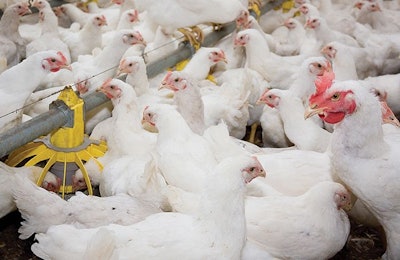
Biosecurity is an essential piece of modern poultry production, but it requires a commitment to setting up and following a management plan.
As part of the U.S. Poultry & Egg Association’s 2018 Live Production, Welfare & Biosecurity Seminar in Nashville, Tennessee, Dr. Jenny Nicholds, clinical associate professor of avian medicine in the Poultry Diagnostic and Research Center in the College of Veterinary Medicine at the University of Georgia, spoke about the importance of operational biosecurity on September 18. She said poultry farm biosecurity should be thought of in three phases: preventing the introduction of pathogens to the farm, reducing their multiplication and spread, and killing them to prevent their spread in between flocks.
Perpetual need for biosecurity
Biosecurity is necessary to protect the lives of the animals and the well-being of the farm. The need to control foodborne, human pathogens is constant, and preventing disease outbreaks becomes more important as the population of antibiotic-free and no-antibiotics-ever birds grows. Indemnity and compensation for disease losses are tied to biosecurity, too.
Essentially, biosecurity is about risk management. Mitigating risk to the farm boils down to preventing the introduction of a disease and the containment of disease should it occur. There is no silver bullet for biosecurity. It is a product of constant management. Nicholds said the good news is farmers should already know what they need to do to run a biosecure operation and that biosecurity measures work when carried out properly.
On-farm biosecurity
Nicholds’ expertise lies in on-farm biosecurity. She said the conditions vary depending upon the type of farm – pullet, breeder, broiler or layer – but there are constants. Farmers must prevent the introduction of infectious agents such as bacteria, viruses, fungi or parasites, reduce their multiplication and kill the pathogen.
Preventing introduction of pathogens
Keeping pathogens like Salmonella from entering the farm requires a focus on human, animal and inanimate vectors. Farmers must control visitors and ensure everyone on-site is adhering to biosecure practices.
Simple steps like washing hands before and after coming in contract with live poultry, and changing clothes before entering and exiting poultry areas are important, as is maintaining a line of separation between clean and dirty areas. Nicholds said something like a Danish entry may seem too complicated, however simplifying entry through the use of physical barriers between open and biosecure areas helps enforce biosecure practices.
Visitors should be kept to a minimum and, when they are on the farm, should be provided with the necessary, clean protective equipment. Trucks and tools moving between poultry farms should be cleaned and disinfected.
Along with humans, farmers must consider animal sources. Rodents and insects bring disease into the house, but household animals like dogs and wild animals like geese can introduce pathogens, too.

Vectors like rodents and insects introduce pathogens into the house. Eradicate them and control their points of entry. | Sergey_Siberia88, Bigstock.com
Reducing multiplication
Poultry farmers must also contend with pathogens that are inherently present on farms like E. coli and Coccidia. This is where reducing multiplication, and taking away opportunities to infect, comes into play.
Effectively controlling multiplication requires proper management of the birds and their living conditions. Nicholds said when farmers do right by the bird in terms of management and welfare, pathogen reduction will fall into place.
Infection happens when the animal’s protective barriers – the skin, the respiratory tract or the intestinal tract – are breached by a pathogen. She focused on the importance of the respiratory tract as an infection point.
Protecting the respiratory tract
The avian respiratory tract plays a role in removing and trapping debris in the air. The upper respiratory tract is an important first line of defense against disease. The mucociliary apparatus – a system of cilia that pushes potentially disease-laden debris out of the respiratory tract – lies between the chicken’s nasal cavity and lungs.
This apparatus plays a key role in protecting the bird and the farmer from disease, but damage to the respiratory tract compromises its function. Factors in the house like moisture content and ammonia content of the litter and air, dust particle counts and even ventilation can affect the respiratory tract.
Nicholds said moisture levels in the house play a huge role in the health of the respiratory tract. Birds consume two pounds of water for every one pound of feed and 80 percent of that moisture is returned to the house. Because of this, farmers must monitor and tweak ventilation as well as the litter to control the moisture level in the house. Too much moisture stimulates pathogen populations and drives up ammonia content, while too little moisture kicks irritating and microorganism-heavy dust into the air.
Proper use of vaccines
A slew of viral, bacterial and fungal actors can harm the respiratory system as well. Biosecurity measures keep these agents out, but farmers also intentionally introduce infectious agents – through vaccines – which can open the door for other pathogens if they are not properly managed.
Vaccination plays a crucial role in preventing disease multiplication and spread, but farmers cannot forget that proper management of vaccinated birds is key to the success of a vaccine program. In the case of some viruses, vaccinated birds can spread the pathogen they were vaccinated against to non-vaccinated birds, resulting in disease challenges for the flock.
Killing the pathogen
The final aspect of on-farm biosecurity is killing the pathogen to prevent disease spread in between subsequent flocks. This is best done by disinfecting the farm as best as possible through the cleaning of water lines and the use of litter amendments and treatments to control pathogen load and moisture content.
Along with this, farmers must eradicate disease vectors like insects and rodents using insecticide and rodenticides and taking full measures to control their points of entry. Routine maintenance – inspecting rodent control stations, keeping hand sanitizers stocked and dispensers full, removing leftover feed from the previous flock and cleaning up feed spills – must also be performed to minimize pathogen spread between flocks.

















